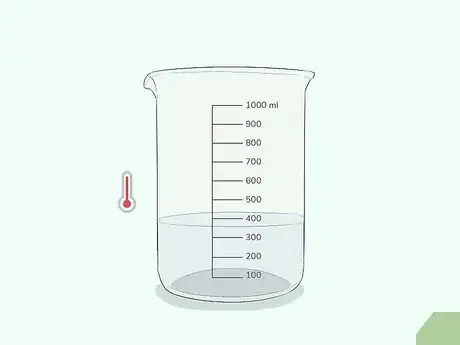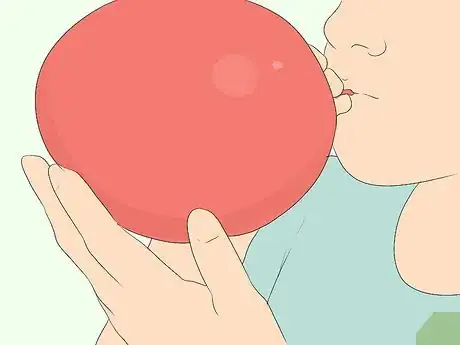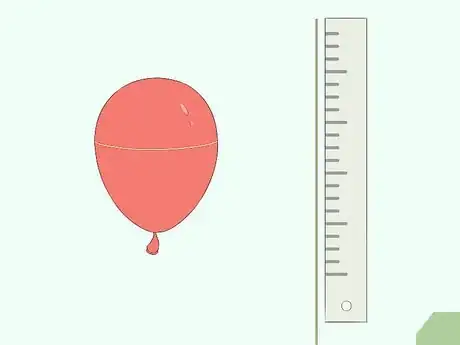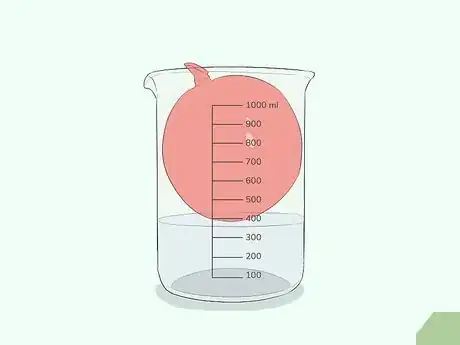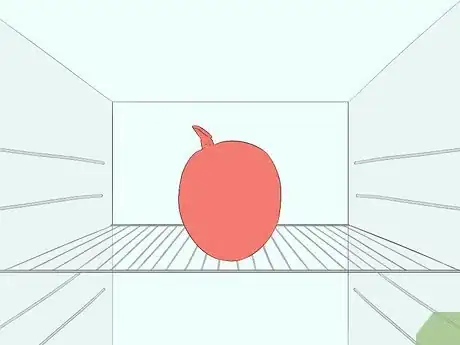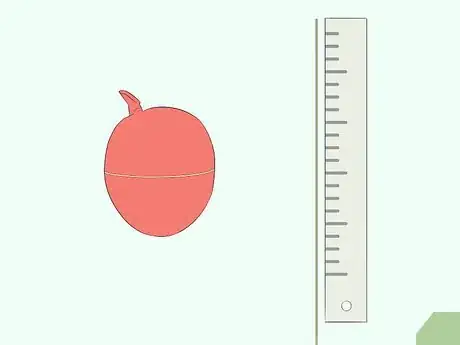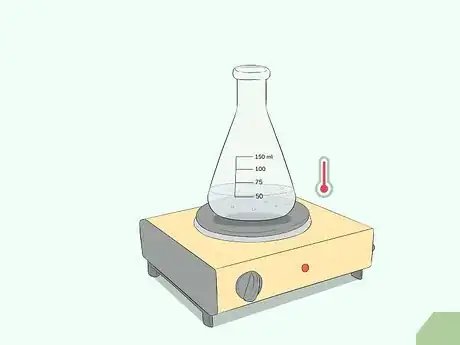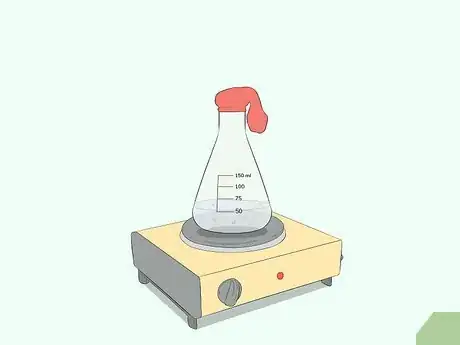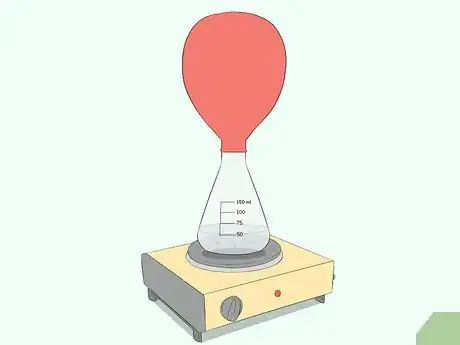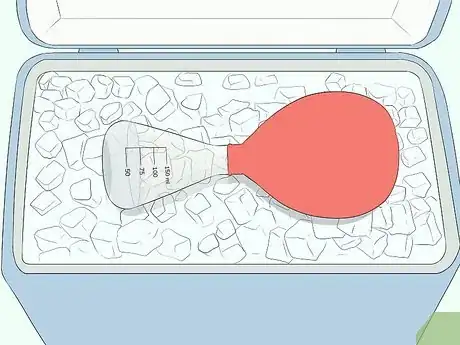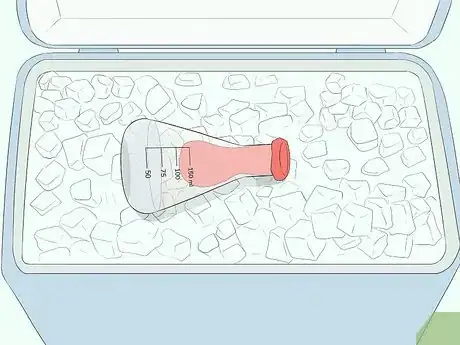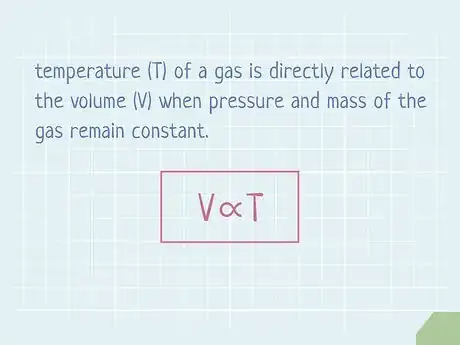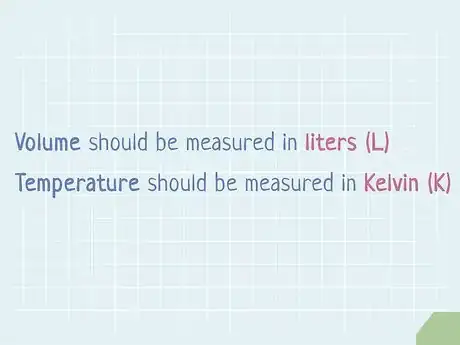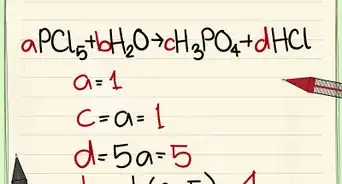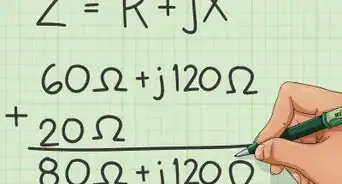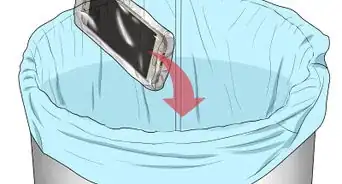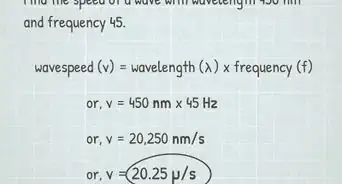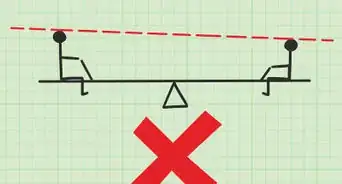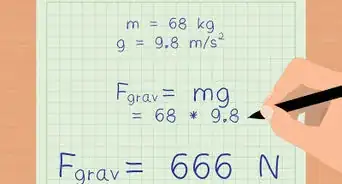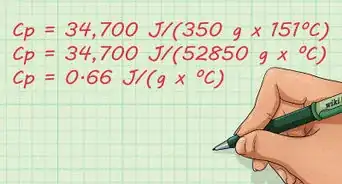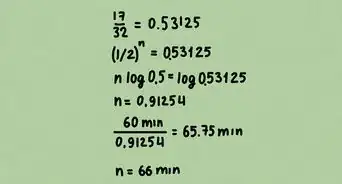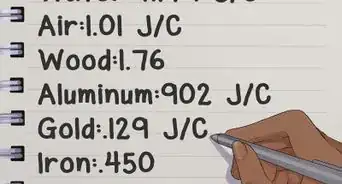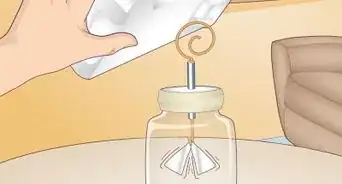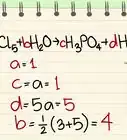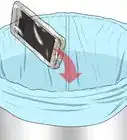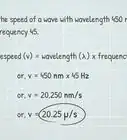This article was co-authored by Bess Ruff, MA. Bess Ruff is a Geography PhD student at Florida State University. She received her MA in Environmental Science and Management from the University of California, Santa Barbara in 2016. She has conducted survey work for marine spatial planning projects in the Caribbean and provided research support as a graduate fellow for the Sustainable Fisheries Group.
There are 12 references cited in this article, which can be found at the bottom of the page.
wikiHow marks an article as reader-approved once it receives enough positive feedback. In this case, 80% of readers who voted found the article helpful, earning it our reader-approved status.
This article has been viewed 208,153 times.
Charles's Law states that the volume of an ideal gas changes proportionally to the temperature of that gas, given that pressure and amount of gas present are held constant. The equation for Charles's law can be expressed as V1/T1=V2/T2. In other words, if a balloon is filled with air, it will shrink if cooled and expand if heated. This happens because the air inside the balloon, which is a gas, takes up a smaller volume when it is cool, and takes up a larger volume when it is heated.
Steps
Demonstrating Charles’s Law with an Inflated Balloon
-
1Add boiling water to a beaker or other container. You should leave room to put a balloon in the container as well. Adding about 100 mL of water to a 1000 mL (1 L) beaker will work in most cases. Avoid spilling the water on yourself or anyone else to avoid injury.[1]
-
2Fill a balloon with air. Blow into the balloon with your mouth, or use a pump to fill it.[2] Do not overfill the balloon ― you want to leave room for the gas inside to expand. It is best to use a party balloon instead of a water balloon. This decreases the chance that the balloon will pop. [3] If you plan to put the balloon into the container, do not blow it up so large that it will not fit in the opening.Advertisement
-
3Wrap a string around the widest part of the balloon. By wrapping a piece of string around the balloon, you can get an accurate measurement of how big the balloon is in the beginning. Either mark or cut the string at at the widest part of the balloon. Remove the string from the balloon and measure it with a ruler. This measurement is the original circumference of your balloon. You will want to compare this to the size of the balloon once the air inside heats up.[4]
-
4Place the balloon in the container but out of the water. This will allow heat from the water to transfer to the air inside the balloon. If the balloon does not fit inside the container, another option is to put it on top of the container. The heat transfer may be a little less efficient, but it will still have the same effect on the balloon.
-
5Watch as the balloon gets larger. The increase in temperature will force the air to increase its volume, thus expanding the balloon. It will look like the balloon is growing or inflating inside the container. Use another piece of string to measure the circumference of the balloon when heated. Now, you can compare it to the original circumference.
- Do not let the balloon expand too much, as this may cause it to pop.
-
6Move the balloon to the freezer. Now that you have added heat to expand the balloon, removing the heat will allow the balloon to deflate. To observe this, you will need to move the balloon from the heat source (your container of boiling water) and into a cold environment. Make sure the balloon is completely dry before placing it in the freezer. You should leave the balloon in the freezer for at least a couple of hours before removing it.[5]
-
7Observe the size of the balloon. When you remove the balloon from the freezer, immediately measure the circumference with a third piece of string. This way, you can compare it to your first two measurements. It should not only be smaller than it was in the warm container, but should be even smaller than it was when you first inflated it. This is because you removed heat from the gas inside the balloon, which forced the gas (and in turn the balloon) to decrease in volume.[6]
Demonstrating Charles’s Law by Expanding and Contracting a Balloon
-
1Add a small amount of water to an Erlenmeyer flask. You do not need to fill the flask. The less water you add, the faster you will be able to bring it to a boil. However, make sure that you do add enough water so that you don’t boil it off too quickly. About 75 mL should do nicely.
-
2Place the flask on a hot plate or burner. This will serve as a heat source for your water. Make sure you heat the water to the boiling point. This will force air to expand out of the top of the flask and also generate water vapor to fill the balloon.[7]
-
3Put the open end of a balloon over the opening of the flask. Remember that the flask is being heated. You should use gloves to avoid burning your hands as you secure the balloon over the opening of the flask. Make sure that the balloon is far enough down on the neck of the flask that it does not pop off easily.[8]
- It may be easier and safer to put the balloon on the flask before heating the water.
-
4Observe the expansion of the balloon. Securing the balloon over the top of the flask will create a seal and only allow the air to expand into the balloon. This expansion of air into the balloon will cause the balloon itself to expand. Do not let the balloon get so large that it pops.[9]
-
5Move the flask to an ice bath. To prepare the ice bath just put water and ice into a container. This is a very easy and fast way to cool the contents of the flask. Use gloves to transfer the flask from the heat source to the ice bath.[10]
-
6Observe the suction on the balloon. The rapid cooling of the gas inside of the flask and balloon will cause the volume of the gas to decrease. As the volume decreases, the volume of the balloon will also decrease, causing it to shrink. As the gas cools even more and contracts even more, the volume of the gas shrinks so much that the pressure outside the flask pushes the balloon completely inside the flask.[11]
Demonstrating Charles’s Law Mathematically
-
1Consider the relationships at play between ideal gas properties. It was shown by Jacques Charles and then later by Joseph Gay-Lussac that the temperature of a gas is directly related to the volume when pressure and mass of the gas remain constant. This means that, for a given gas, the volume of the gas divided by the temperature of the gas will yield the same number for each volume-temperature combination.[12]
-
2Make sure that your units are correct. Volume should be measured in liters. Temperature should be measured in Kelvin. If your values are in different units, you should use dimensional analysis to convert them to the correct units before proceeding. Otherwise, your calculations will not be correct.[13]
-
3Use k to construct your equation. The initial volume (V1) of a gas divided by the initial temperature (T1) of that gas is equal to some constant, k. If the volume or temperature of that gas is altered, both values will change such that the new volume (V2) divided by the new temperature (T2) will also be equal to the same constant, k. Since V1/T1=k and V2/T2=k, V1/T1=V2/T2.[14]
-
4Solve the equation for the unknown variable. When given a problem to solve, you will be provided some of the measurements and asked to calculate a missing piece of the equation. Scan the problem for all given values and place them in the appropriate part of the equation. Once you have all known values in your equation, just rearrange the equation so that your unknown value is alone, and then do the arithmetic. You will have used Charles’s Law to solve your problem.[15]
Expert Q&A
Did you know you can get expert answers for this article?
Unlock expert answers by supporting wikiHow
-
QuestionWhy does the balloon shrink inside the freezer?
 Bess Ruff, MABess Ruff is a Geography PhD student at Florida State University. She received her MA in Environmental Science and Management from the University of California, Santa Barbara in 2016. She has conducted survey work for marine spatial planning projects in the Caribbean and provided research support as a graduate fellow for the Sustainable Fisheries Group.
Bess Ruff, MABess Ruff is a Geography PhD student at Florida State University. She received her MA in Environmental Science and Management from the University of California, Santa Barbara in 2016. She has conducted survey work for marine spatial planning projects in the Caribbean and provided research support as a graduate fellow for the Sustainable Fisheries Group.
Environmental Scientist The balloon shrinks inside the freezer because, as Charles's Law explains, air contracts in lower temperatures. The cooler temperature slows the speed at which the air molecules are moving within the balloon, which means there isn't as much space between molecules, causing the air, and therefore the balloon, to contract.
The balloon shrinks inside the freezer because, as Charles's Law explains, air contracts in lower temperatures. The cooler temperature slows the speed at which the air molecules are moving within the balloon, which means there isn't as much space between molecules, causing the air, and therefore the balloon, to contract. -
QuestionWhat is happening to the balloon in these experiments?
 Community AnswerAs you heat the air inside the balloon, it expands to take up more volume. This pushes the walls of the balloon out, making it bigger. When you cool the air inside the balloon, the opposite happens. The air contracts to take up less volume, which allows the walls of the balloon to contract as well. This makes the balloon smaller.
Community AnswerAs you heat the air inside the balloon, it expands to take up more volume. This pushes the walls of the balloon out, making it bigger. When you cool the air inside the balloon, the opposite happens. The air contracts to take up less volume, which allows the walls of the balloon to contract as well. This makes the balloon smaller. -
QuestionIf given 277V/147.5 = 1, how do I solve the equation for V?
 Community AnswerThe first step is to get your variable, V, on one side of the equation and all of your known values on the other side. In this case, you would start by multiplying both sides of the equation by 147.5. This gives you 277V = 147.5. Next, divide both sides of the equation by 277 to get V = 147.5/277. Doing the math leaves you with V = 0.53. As you can see, this equation doesn't contain any units, which is a problem. 0.53 L is very different from 0.53 mL. Always be sure to include units for all values when solving the equation.
Community AnswerThe first step is to get your variable, V, on one side of the equation and all of your known values on the other side. In this case, you would start by multiplying both sides of the equation by 147.5. This gives you 277V = 147.5. Next, divide both sides of the equation by 277 to get V = 147.5/277. Doing the math leaves you with V = 0.53. As you can see, this equation doesn't contain any units, which is a problem. 0.53 L is very different from 0.53 mL. Always be sure to include units for all values when solving the equation.
Warnings
- Be careful not to let the balloon expand too much. This will cause it to burst.⧼thumbs_response⧽
- If you are using boiling water, exercise caution. You could easily be burned.⧼thumbs_response⧽
Things You’ll Need
Demonstrating Charles’s Law with an Inflated Balloon
- Party Balloons
- Beaker
- Water
- Heat Source
- Freezer
- String
- Ruler
Demonstrating Charles’s Law by Expanding and Contracting a Balloon
- Erlenmeyer Flask
- Water
- Hot Plate
- Party Balloon
- Heat Resistant Gloves
- Ice
References
- ↑ https://www.youtube.com/watch?v=NplVuTrr59U?=youtu.bet=75
- ↑ https://chemdemos.uoregon.edu/demos/Liquid-Nitrogen-Balloon-Charles-Law#
- ↑ https://www.youtube.com/watch?v=NplVuTrr59U?=youtu.bet=58
- ↑ https://www.youtube.com/watch?v=NplVuTrr59U?=youtu.bet=99
- ↑ https://www.youtube.com/watch?v=NplVuTrr59U?=youtu.bet=117
- ↑ https://www.youtube.com/watch?v=NplVuTrr59U?=youtu.bet=121
- ↑ https://www.youtube.com/watch?v=QjDJgF9H580?=youtu.b&t=20
- ↑ https://www.youtube.com/watch?v=QjDJgF9H580?=youtu.bet=34
- ↑ https://www.youtube.com/watch?v=QjDJgF9H580?=youtu.bet=34
- ↑ https://www.youtube.com/watch?v=QjDJgF9H580?=youtu.bet=53
- ↑ https://www.youtube.com/watch?v=QjDJgF9H580?=youtu.b&t=60
- ↑ http://www.chemteam.info/GasLaw/Gas-Charles.html
- ↑ https://chem.libretexts.org/Bookshelves/General_Chemistry/Map%3A_A_Molecular_Approach_(Tro)/05%3A_Gases/5.03%3A_The_Simple_Gas_Laws-_Boyles_Law_Charless_Law_and_Avogadros_Law
- ↑ http://www.chemteam.info/GasLaw/Gas-Charles.html
- ↑ https://chem.libretexts.org/Bookshelves/General_Chemistry/Map%3A_A_Molecular_Approach_(Tro)/05%3A_Gases/5.03%3A_The_Simple_Gas_Laws-_Boyles_Law_Charless_Law_and_Avogadros_Law
